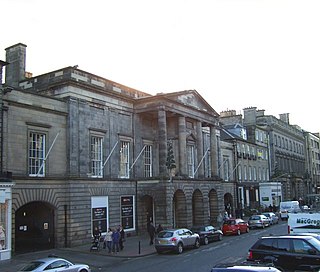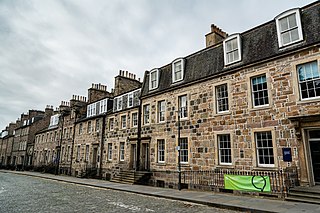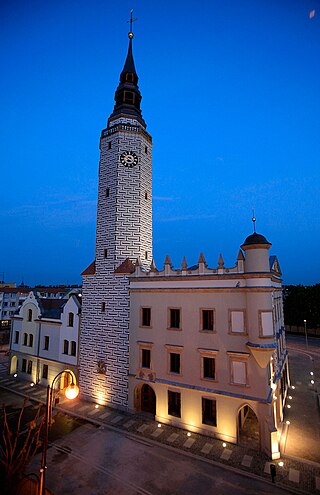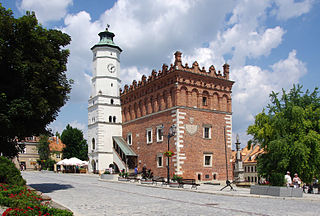
Kluczbork is a town in southern Poland with 23,554 inhabitants (2019), situated in the Opole Voivodeship. It is the capital of Kluczbork County and an important railroad junction.

Benedict College is a private historically black college in Columbia, South Carolina, United States. Founded in 1870 by northern Baptists, it was originally a teachers' college. It has since expanded to offer majors in many disciplines across the liberal arts. The campus includes buildings in the Benedict College Historic District, a historic area listed on the National Register of Historic Places.

Georgetown City Hall is a nineteenth-century Gothic Revival building located on the corner of Regent Street and Avenue of the Republic in Georgetown, Guyana. The building was designed by architect Reverend Ignatius Scoles in 1887, and was completed in June 1889. The building houses the offices of the Mayor, the City Council, and the City Engineer.

The Campbell is a bar and cocktail lounge in Grand Central Terminal in Midtown Manhattan, New York City. The space, long known as the Campbell Apartment, was once the office of American financier John W. Campbell, a member of the New York Central Railroad's board of directors. It was later used as office space, as a studio by CBS and as a jail by Metro-North Railroad. Renovations in 1999 and 2007 restored the space to its original opulence at a total cost of nearly $2 million. Temporarily closed in 2016, the bar was reopened the following year under new management.

Victoria Public Hall, or the Town Hall, is a historical building in Chennai, named after Victoria, Empress of India. It is one of the finest examples of British architecture in Chennai and was built to commemorate the Golden Jubilee of Queen Victoria. In the late 19th and early 20th centuries, it was used as a theater and a place for public gatherings. The South Indian Athletic Association Club now resides there.

Opole Główne is a major railway station in the southern Polish city of Opole. It also is the biggest station in Opole Voivodeship, with connections to all major Polish cities, several local towns of the area, as well as international locations, such as Berlin and Hamburg.

The Assembly Rooms are meeting halls in central Edinburgh, Scotland. Originally solely a meeting place for social gatherings, it is now also used as an arts venue and for public events, including the Edinburgh Festival Fringe and the Hogmanay celebrations. There are four rooms, with moveable chairs or tables, that are used year-round and are available for private functions: Music Hall, Ballroom, Supper Room and Edinburgh Suite.

Sir K. P. Puttanna Chetty Town Hall, locally commonly referred to as Bangalore Town Hall, is a neoclassical municipal building in Bangalore, India, named after the philanthropist and former president of Bangalore City Municipality, Sir K.P Puttanna Chetty.

George Square is a city square in Edinburgh, Scotland. It is in the south of the city centre, adjacent to the Meadows. It was laid out in 1766 outside the overcrowded Old Town, and was a popular residential area for Edinburgh's better-off citizens. In the 1960s, much of the square was redeveloped by the University of Edinburgh, although the Cockburn Association and the Georgian Group of Edinburgh protested. Most but not all buildings on the square now belong to the university. Principal buildings include the Gordon Aikman Lecture Theatre, Edinburgh University Library, 40 George Square and Appleton Tower.

Namysłów Town Hall was built in the second half of the fourteenth century. Formerly built in Gothic style but then built into the Renaissance style, in 2002 the town hall was renovated. Today it is recognised as one of the most beautiful cultural points of heritage in Namysłów. The town hall is the main building in the old town square in the city, located in the centre of the square. The town hall was added to the list of Registered Cultural Heritage with the position 939/64 in 1964.

Głogówek Town Hall - a Renaissance building built in 1608, and in the subsequent years frequently renovated and reconstructed. In 1945, the building was partially burnt down, and later rebuilt between 1955 and 1957. Currently, the town hall is the seat for the Głogówek City Council.

Głubczyce Town Hall - a Renaissance building in Głubczyce, Głubczyce County, Opole Voivodeship; in Poland. The first mention of a town hall in Głubczyce was in 1383, when a thirteenth-century townhouse was reconstructed into the town hall. The town hall's Renaissance architectural style structure and attic style was built in 1570. Reconstructions in the years of 1863-1864 and 1936, gave the building its Neo-Gothic architectural style. The town hall's decorative statues and towers were built in the nineteenth century. The town hall was renovated in 2006, partly funded by the European Union.

Grodków Town Hall - a town hall built in the Classical architectural style in 1840, designed by architect Philippi, using the tower of the former town hall. Currently, the building is the seat of the Grodków City Council and other institutions.

Olesno Town Hall - a Classical architectural style building built between 1820 and 1821, in the location of a former building from the seventeenth-century. The building was expanded in 1880, and in 1945 burnt down, and subsequently rebuilt after World War II. Currently, the office space in the town hall is rented.

Sandomierz Town Hall – a building raised shortly after the Lithuanian Invasion in 1349. Formerly Gothic, the town hall had an octagonal tower. The southern side, being the oldest was built at the turning point of the fourteenth and fifteenth-century. In the sixteenth century, the building was expanded, in the form of an extended rectangular structure, which was then top outed with an attic tripartite, constructed by Italian sculptor Jan Maria Padovano. The corners of the attic are decorated with heads represented the four estates of the realm. The tower was built in the seventeenth century.

Neptune's Fountain is a historic fountain in Gdańsk, a mannerist-rococo masterpiece, and one of the most distinctive landmarks of the city. The fountain is located at the Długi Targ, in front of the entrance to the Artus Court. It was constructed in the early 17th century. Kashubians use a nickname Krësztof for the sculpture.

Gdańsk Main Town Hall is a historic Ratusz located in the Gdańsk Main City borough of Śródmieście. It is one of the finest examples of the Gothic-Renaissance historic buildings in the city, built at the intersection of Ulica Długa and Długi Targ, in the most popular part of Gdańsk. The Main Town Hall in Gdańsk houses the History Museum of the City of Gdańsk.

Hove Town Hall is the headquarters of Brighton and Hove City Council. The current building was constructed in 1970 in the Brutalist style by John Wells-Thorpe, to replace the original 1882 Hall which was damaged by fire in 1966.

The Bern Town Hall is the building in Bern, Switzerland that houses the Grand Council of Bern, the Executive Council of Bern and the Grand Council of the City of Bern. The building is part of the UNESCO World Heritage Site of the Old City of Berne and is a Swiss heritage site of national significance.

The University Hall in Leuven, Belgium, is a medieval cloth hall with 17th and 18th-century extensions that is now the main administrative building of the KU Leuven. Heavily damaged during the Sack of Leuven in August 1914, the building was restored 1921–1926. It has been a listed building since 26 November 1942, and protected built heritage since 14 September 2009. The building fills most of a block, with entrances on three of the surrounding streets at Krakenstraat 2, Naamsestraat 22, and Oude Markt 13.
























